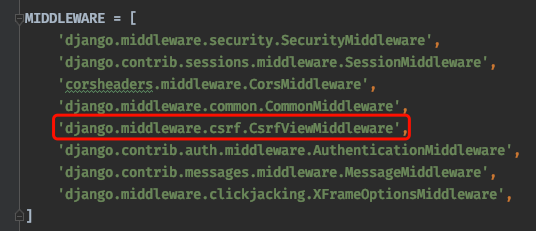什么是CSRF?
浏览器在发送请求的时候,会自动带上当前域名对应的cookie内容,发送给服务端,不管这个请求是来源A网站还是其它网站,只要请求的是A网站的链接,就会带上A网站的cookie。浏览器的同源策略并不能阻止CSRF攻击,因为浏览器不会停止js发送请求到服务端,只是在必要的时候拦截了响应的内容。或者说浏览器收到响应之前它不知道该不该拒绝。
攻击过程
用户登陆A网站后,攻击者自己开发一个B网站,这个网站会通过js请求A网站,比如用户点击了某个按钮,就触发了js的执行。
防止攻击
- Double Submit Cookie
攻击者是利用cookie随着http请求发送的特性来攻击。但攻击者不知道 cookie里面是什么。
Django中是在表单中加一个隐藏的 csrfmiddlewaretoken,在提交表单的时候,会有 cookie 中的内容做比对,一致则认为正常,不一致则认为是攻击。由于每个用户的 token 不一样,B网站上的js代码无法猜出token内容,对比必然失败,所以可以起到防范作用。
- Synchronizer Token
和上面的类似,但不使用 cookie,服务端的数据库中保存一个 session_csrftoken,表单提交后,将表单中的 token 和 session 中的对比,如果不一致则是攻击。
这个方法实施起来并不困难,但它更安全一些,因为网站即使有 xss 攻击,也不会有泄露token的问题。
Django使用CsrfViewMiddleware中间件进行CSRF校验,默认开启防止csrf(跨站点请求伪造)攻击,在post请求时,没有携带csrf字段,导致校验失败,报403错误。那么我们如何解决这种403错误呢?
解决方法
1. 去掉项目的CSRF验证

注释掉此段代码即可,但是不推荐此方式,将导致我们的网站完全无法防止CSRF攻击。
2. 前端表单中增加csrf信息
<form enctype="multipart/form-data" method="post" action="{% url 'add_data' %}">
{% csrf_token %}
</form>
一定要注意后端使用render而不要使用render_to_response进行渲染,这样前端就会有csrf_token变量,前端cookies中也会出现csrftoken数据,然后在HTML中使用即可。这种方式只限制在form表单中使用,ajax请求不支持。
3. 指定请求去掉CSRF校验
可以只针对指定的路由去掉CSRF校验,这也分为两种情况:
- FBV:以函数实现路由处理
# 导入,可以使此次请求忽略csrf校验 from django.views.decorators.csrf import csrf_exempt # 在处理函数加此装饰器即可 @csrf_exempt def add_data(request): result = {} # TODO return HttpResponse(result)
- CBV:以类实现路由处理
from django.views import View from django.views.decorators.csrf import csrf_exempt from django.utils.decorators import method_decorator class IndexView(View): @method_decorator(csrf_exempt) def dispatch(self, request, *args, **kwargs): return super().dispatch(request, *args, **kwargs) def get(self, request, *args, **kwargs): return render(request, 'home.html') def post(self, request, *args, **kwargs): data = request.POST.get('data') qr_path = gen_qrcode(data) return HttpResponse(qr_path)
或者用下面的方式,把装饰器放在类外面
from django.views import View from django.views.decorators.csrf import csrf_exempt from django.utils.decorators import method_decorator @method_decorator(csrf_exempt, name='dispatch') class IndexView(View): def get(self, request, *args, **kwargs): return render(request, 'home.html') def post(self, request, *args, **kwargs): data = request.POST.get('data') qr_path = gen_qrcode(data) return HttpResponse(qr_path)
4. 为所有请求添加csrf校验数据(推荐)
以上方式都有限制,适用范围比较窄,我们需要一种可以一劳永逸的方式:让所有请求都携带csrf数据。因为我们是使用Django模板渲染前端页面的,所以一般会先定义一个base.html,其他页面通过{% extends "base.html" %}来引入使用,那么在base.html中添加ajax的全局钩子,在请求时添加csrf数据即可。
<!DOCTYPE html>
<html>
<head>
<meta charset="utf-8">
<title>{% block title %}首页{% endblock %}</title>
<link rel="stylesheet" href="{% static 'css/base.css'%}">
<script src="https://cdn.bootcss.com/jquery/3.4.1/jquery.min.js"></script>
<script>
$.ajaxSetup({
data: {
csrfmiddlewaretoken: '{{ csrf_token }}'
}
})
</script>
{% block css %}
{% endblock %}
</head>
<body>
4. 在ajax请求中在beforeSend中加入csrf校验数据
$('#get_tencentcloud_instances').click(function () { $.ajax({ url: "{{ request_url }}", type: "POST", data: $('#form_data_edit').serialize(), beforeSend: function (xhr,settings) { xhr.setRequestHeader("X-CSRFtoken",$.cookie("csrftoken")); layer.msg('同步数据中,请等待......', {icon: 4,time:600000}); }, success: function (data) { if (data.code == 0){ layer.alert(data.msg, {icon: 6}); } else { layer.alert(data.msg, {icon: 7}); } }, complete: function () { console.info("同步数据执行完成......"); }, error: function (data) { console.info("同步数据执行出错......"); } }); })
转自: https://www.cnblogs.com/small-bud/p/12381813.html